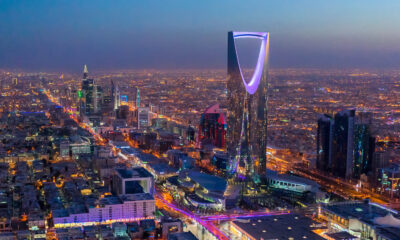Business
Top 10 Investing Countries in Saudi Arabia: Discovering the Numbers and Facts

Riyadh, Saudi Arabia – According to data released by the Saudi Ministry of Investment, the United Arab Emirates (UAE) has emerged as the leading foreign investor in the Kingdom, with a staggering total investment of $27.8 billion by the close of 2022. This significant influx of capital underscores the growing confidence of foreign investors in the Saudi economy and solidifies Saudi Arabia’s position as a key destination for foreign investments in the region.

The Rankings:
- United Arab Emirates (UAE): $27.8 billion
- The UAE takes the top spot, demonstrating its robust commitment to investing in Saudi Arabia. The close economic ties between the two nations, coupled with shared cultural affinities, have fostered a deep understanding of the local market dynamics.
- Luxembourg: $27.5 billion
- Luxembourg follows closely, with substantial investments in various sectors within the Kingdom. Its strategic positioning as a financial hub contributes to its strong presence in Saudi Arabia.
- United States: $20.4 billion
- American investors have shown keen interest in Saudi Arabia, contributing significantly to the country’s economic growth. Their investments span diverse industries, from technology to energy.
- Kuwait: $17.4 billion
- Kuwaiti investors recognize the potential of the Saudi market and have actively participated in various projects. Their contributions bolster bilateral relations and enhance economic cooperation.
- Netherlands: $16.1 billion
- The Netherlands’ investments reflect its confidence in Saudi Arabia’s stability and growth prospects. Dutch companies have made substantial commitments across sectors such as logistics, agriculture, and technology.
- United Kingdom: $15.9 billion
- The UK’s historical ties with Saudi Arabia continue to drive investment. British companies have capitalized on opportunities in infrastructure, finance, and healthcare.
- Bahrain: $8.9 billion
- Bahrain, a close neighbor, has leveraged its proximity to invest significantly in Saudi Arabia. Joint ventures and collaborations between the two countries have strengthened economic ties.
- Jordan: $7.5 billion
- Jordanian investors recognize the Kingdom’s potential and have actively participated in real estate, tourism, and renewable energy projects. Their contributions enhance regional economic integration.
- Japan: $6.7 billion
- Japanese companies have strategically invested in Saudi Arabia, particularly in technology, automotive, and healthcare. Their long-term vision aligns with Saudi Arabia’s ambitious Vision 2030 goals.
- France: $6.1 billion
- French investors have diversified their portfolio in Saudi Arabia, focusing on sectors like defense, aerospace, and luxury goods. Their commitment reflects confidence in the Kingdom’s economic reforms.
Insights and Implications:
- Neighborly Trust: The substantial investments from neighboring countries—UAE, Kuwait, Bahrain, Jordan, and Egypt—highlight their deep understanding of the Saudi economic landscape. Geographical proximity and cultural ties play a crucial role in fostering this trust. These investors are well-versed in the region’s opportunities and challenges, reinforcing the effectiveness and sustainability of Saudi Arabia’s strategic initiatives.
- Saudi Arabia’s Economic Resilience: The consistent inflow of foreign capital underscores the Kingdom’s resilience and adaptability. Investors recognize the stability of Saudi Arabia’s economic policies and the government’s commitment to diversification and modernization.
As Saudi Arabia continues to attract global investors, its role as a regional economic powerhouse becomes increasingly prominent. The numbers speak for themselves, reflecting not only financial transactions but also the shared vision of progress and prosperity. The Saudi economy remains open for business, welcoming investors from around the world to participate in its transformative journey. 🌟📈🇸🇦
Business
Financial Influencer Jenny Okpechi Shares How Early Investing Helped Her Build a Six-Figure Portfolio

Financial influencer Jenny Okpechi, known online as @savvymoneygirl, is championing the power of early and consistent investing after building a multiple six-figure portfolio through smart financial planning and diversified income streams.
Speaking to Euronews, Okpechi emphasized that wealth-building is a long-term process rooted in discipline, education, and strategic action—not overnight success. Her financial journey began at just 16, when she started saving and investing small amounts despite limited resources.
“I started very young and very intentionally,” she said. “I learned to budget, live within my means, and gradually moved from saving to investing in treasury bills, corporate bonds, and stocks.”
Raised in a traditional African household where financial decision-making was often seen as a male role, Okpechi had to push against cultural barriers. “I wanted to prove that women could manage and grow money just as well,” she said. That determination led her to pursue multiple sources of income while also studying, including paid surveys, tutoring, and blogging.
Today, Okpechi boasts eight income streams, ranging from her full-time job as a Scrum Master and a part-time healthcare assistant role, to digital product sales, affiliate marketing, brand collaborations, and investments in REITs, index funds, and stocks. She is also building Moneybestie, a fintech app aimed at improving financial literacy among women and girls.
“I pay myself first and invest consistently. I only invest in what I understand—nothing fancy, just steady and simple,” she said. She credits compound interest and the discipline of regular investing as major factors in her portfolio growth.
Okpechi encourages young people to start investing early—even with small amounts. “Don’t wait until you earn more. Start with £25 a month if that’s all you can. Automate it, and let time do the work,” she advised. “Time in the market beats timing the market.”
Despite her success, Okpechi has faced challenges—from overcoming imposter syndrome in the male-dominated finance and tech industries to battling burnout while juggling multiple roles. She also confronted deep-rooted gender biases that undervalue women’s financial potential.
Her message to aspiring investors is clear: “Learn about money like your financial freedom depends on it—because it does. Talk about money, forgive your financial mistakes, and keep moving forward.”
With Generation Z reportedly beginning to invest earlier than previous generations—at an average age of 19—Okpechi’s story offers both inspiration and practical guidance for anyone looking to secure their financial future.
Business
U.S. Economy Contracts for First Time in Three Years Amid Tariff Turmoil
Business
Stellantis Appoints Antonio Filosa as CEO Amid Profit Slump and Strategic Challenges

Stellantis has named Antonio Filosa, its Chief Operating Officer for North America, as the company’s new Chief Executive Officer, following the unexpected resignation of former CEO Carlos Tavares in December. Filosa, 51, will formally assume the role on June 23, pending approval at an upcoming shareholder meeting.
The announcement, made on Monday, comes at a turbulent time for the world’s fourth-largest carmaker, which has been grappling with slowing sales in key markets and internal disagreements over the pace of electrification.
Stellantis, the multinational automotive group behind 14 brands including Peugeot, Fiat, Chrysler, Citroën, and Jeep, issued a profit warning last September due to slumping demand in the United States and Europe. The warning preceded the abrupt exit of Tavares, who reportedly clashed with the board over his aggressive push for a full transition to battery electric vehicles (BEVs) in Europe by 2030. The board had advocated for a more gradual approach.
Filosa’s appointment signals a strategic reset for the group, which is under pressure from weak North American performance, rising global competition, and trade policy uncertainties, particularly from the United States. Former President Donald Trump’s tariff stance on foreign automakers continues to cast a shadow over multinational manufacturers like Stellantis.
In its official statement, the company praised Filosa for his “proven track record of hands-on success during his more than 25 years in the automotive industry,” as well as his “unrivalled knowledge of the company and recognised leadership qualities.” The Naples-born executive has held various leadership roles across Stellantis’ global operations and was promoted to head of North America shortly after Tavares’ departure.
During his tenure in North America, Filosa has worked to reduce bloated inventories and restore dealer confidence following months of sluggish sales. As CEO, he will now oversee a vast portfolio of brands and be tasked with balancing profitability, innovation, and sustainability across diverse markets.
Filosa’s leadership will be closely watched as Stellantis navigates regulatory shifts, intensifying competition in electric vehicles, and a volatile geopolitical landscape. The shareholder meeting to confirm his appointment is expected to be announced in the coming days.
-

 Business1 year ago
Business1 year agoSaudi Arabia’s Model for Sustainable Aviation Practices
-

 Business1 year ago
Business1 year agoRecent Developments in Small Business Taxes
-

 Politics1 year ago
Politics1 year agoWho was Ebrahim Raisi and his status in Iranian Politics?
-

 Business11 months ago
Business11 months agoCarrectly: Revolutionizing Car Care in Chicago
-

 Business11 months ago
Business11 months agoSaudi Arabia: Foreign Direct Investment Rises by 5.6% in Q1
-

 Technology1 year ago
Technology1 year agoComparing Apple Vision Pro and Meta Quest 3
-

 Politics1 year ago
Politics1 year agoIndonesia and Malaysia Call for Israel’s Compliance with ICJ Ruling on Gaza Offensive
-

 Sports10 months ago
Sports10 months agoKeely Hodgkinson Wins Britain’s First Athletics Gold at Paris Olympics in 800m




























